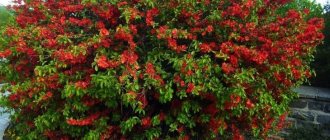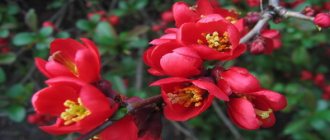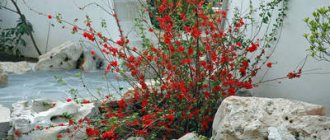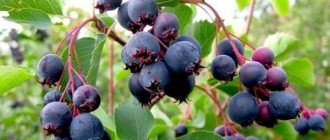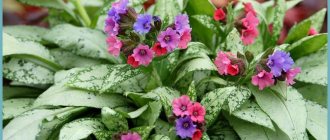The Japanese quince is called chaenomeles by an incomprehensible word. It is a species of shrub that bears fruit similar to a pear. An interesting feature is that the fruits of the tree are not consumed fresh. They are tough and tasteless. But the jam made from them is simply delicious. But taste is not the most important thing. Many people grow this plant for decorative purposes. Japanese quince in bloom is an unforgettable sight!
Name where it grows
According to the botanical description, Chaenomeles is a separate genus of flowering shrubs of the Rosaceae family. It includes Japanese quince, the most common species, and three more varieties of trees. The name comes from a Greek phrase that means “split apple.” The homeland of this beautiful plant is Japan. There you can find wild varieties of shrubs in nature.
The tree began to be cultivated in the 16th century by Japanese breeders. In the 17th century, it came to Europe because of its attractive appearance. Aristocrats planted Chaenomeles bushes near their houses to enjoy the beautiful flowers and their attractive aroma. An interesting feature: the buds of some tree species can change color during flowering. From light shades they turn to peach, and then turn into scarlet. In autumn, deciduous tree species delight the eye with a picturesque combination of changing color foliage and bright fruits.
Now the shrub is grown in Japan, China, Asian countries, and the Mediterranean. Here it grows in Crimea, the Caucasus Mountains, as well as in Ukraine and Belarus. Chaenomeles tolerates drought well, which allows it to be planted in regions with little rainfall. It is also grown in the middle zone, but there the tree freezes without shelter for the winter, so it needs additional care. In our country, chaenomeles is called the northern lemon due to its similarity in appearance and valuable nutritional qualities.
Diseases
With proper care, chaenomeles is rarely affected by pests and diseases.
Chlorosis (yellowing of foliage) will develop in soils with high pH. Flower buds are susceptible to significant damage from severe spring frosts.
During rainy summers, a disease caused by the fungus Cercospora cydoniae may develop. Symptoms of this disease are visible in the second half of summer and appear as small brown spots on the foliage, which then increase in size, forming extensive necrosis.
To prevent the development of this disease, the affected leaves must be removed and burned, and then treated 2-3 times with a fungicide at intervals of 10 days.
What does it look like
The plant is a spreading shrub with a very lush crown. The height is small - one to two meters, rarely reaches six. Many thin branches extend from the trunk, directed in all directions. Often the lower branches bend all the way to the ground, while the upper branches reach into the sky. Among the trees there are evergreen and deciduous. In most species, the branches are lined with thorns. Such shrubs are used to form hedges.
The foliage is dense and bright green. The leaves are oval-shaped, with teeth along the edges, smooth, with a shiny surface. Chaenomeles flowers are the main advantage of the plant. They are presented with beautiful semi-closed buds with a cup of medium depth. The sepals consist of 4 or 5 petals. The diameter of the flower is 3-5 cm, which is quite large for a shrub. Bright stamens emerge from the middle.
Flowers can be solitary, clinging to branches in abundance, or growing in clusters. The palette is very diverse. There are varieties with white and pale pink flowers. In most trees they are scarlet, coral, red, orange. The flowering period is about a month, it begins in May.
Fruit
After the tree has flowered, fruits form from the ovary. Their ripening ends by October. The shape of the fruit resembles pears or apples with an elongated upper part. The size depends on the variety: some look like miniature balls with a circumference of up to 4 cm, others (large-fruited) reach 10-15 cm in length. The color of the fruit is light green, peach, lemon yellow. There are fruits with an orange color. The structure of the pulp is hard and dense. There are a large number of seeds in the center of the fruit, arranged in segments with a white film.
Benefits, composition
Chaenomeles contains many valuable substances that allow it to be used in alternative medicine. It contains organic acids, tannins, essential oils, saponins, and flavonoids. Among vitamins and minerals, the highest concentrations are:
- Retinol - 11 mg
- Vitamin C – 25 mg
- Tocopherol - 0.6 mg
- Nicotinic acid - 0.3 mg
- Folic acid - 0.3 mg
- Potassium - 270 mg
- Magnesium - 12 mg
- Phosphorus – 17 mg
In China, decoctions of fruit pulp are used to treat diseases of the joints, circulatory system, and internal organs. Tea with the addition of honey improves the functioning of the digestive tract and stops inflammatory processes. These drinks tone you up, give you vigor, and direct vital energy in the right direction. A mixture of crushed chaenomeles with ginger and honey successfully eliminates cough and helps remove harmful substances from the respiratory tract.
An infusion of Japanese quince flowers normalizes blood pressure and strengthens the walls of blood vessels. A decoction of the seeds applied to the skin heals burns and wounds. Scientists have discovered substances in the pulp of Chaenomeles that can destroy cancer cells. They stop the process of mutations in healthy tissues and increase the body's resistance to viruses. The healing effect of the plant against nervous diseases, intestinal disorders, and stomach ulcers has also been scientifically confirmed.
Fruits can also be used for cosmetic purposes. Masks made from crushed pulp fight wrinkles, fill the skin with energy, and nourish. Juice from the fresh fruit brightens the epidermis and eliminates age spots. It is also useful for aging skin. Infusions of the leaves of the plant are used to wash the hair, this restores the cuticle, strengthens the roots, and prevents the appearance of gray hair.
Medicinal properties of Japanese quince: scientific data
But the benefits of Chaenomeles are evidenced not only by records in ancient Chinese and Japanese texts. Modern scientists have long taken these fruits into their sights. And I must say, we learned a lot of interesting things about them.
It turned out that polyphenols contained in Japanese quince have anti-cancer properties. Laboratory experiments have shown that substances extracted from Chaenomeles are capable of inhibiting the growth of cancer cells, reducing the ability of healthy cells to mutate, and also neutralizing substances that cause the formation of metastases. Chaenomeles extract has shown itself best in the fight against breast and prostate cancer.
Triterpenes and sterols found in these fruits have been shown to effectively fight streptococcal infections, treat pharyngitis and rheumatism. These substances not only have anti-inflammatory properties, but also reduce swelling in the body. Researchers have also discovered the benefits of Japanese quince for the treatment of sore throat: the fruits contain substances that inhibit the activity of bacteria that cause sore throat.
An experiment on laboratory rats confirmed the effectiveness of Japanese quince as an immunomodulatory product. Scientists have also scientifically confirmed the correct use of chaenomeles for the treatment of arthritis and rheumatism.
Scientists have also identified the most effective form of Chaenomeles for combating inflammation in the joints. This medicine turned out to be a 10% alcohol infusion of Japanese quince.
The fruit extract not only relieves pain and swelling, but also slows down the progression of the disease, and the anti-inflammatory effect on joints provides a long-term effect.
Best materials of the month
- Coronaviruses: SARS-CoV-2 (COVID-19)
- Antibiotics for the prevention and treatment of COVID-19: how effective are they?
- The most common "office" diseases
- Does vodka kill coronavirus?
- How to stay alive on our roads?
Experiments by scientists have confirmed the benefits of chaenomeles for treating the liver (including various types of hepatitis), getting rid of diarrhea and other gastric diseases. Researchers also found that this oriental exotic is very useful for the treatment of nervous disorders, migraines, depression, stomach ulcers, and the fruits should also be consumed to prevent Parkinson’s disease and lower cholesterol.
Fresh fruit pulp has found its application in cosmetology. Such fruit masks are useful for toning facial skin, lightening freckles and age spots, and moisturizing aging skin. A decoction of Japanese quince leaves contains large reserves of copper, and it is known to be the best element for preventing gray hair.
Application
Due to the fact that the pulp of raw fruits is hard and has a sour taste, they are not eaten. However, fruit that has undergone heat treatment acquires excellent taste. It makes delicious preserves and jams. To prepare these dishes, chaenomeles can be diluted with other fruits, such as apples or pears. This will only improve the quality of the finished product. The fruits can also be consumed in dried form. This way they are stored for a long time and retain all their beneficial properties. The following dishes are made from the fruits of Chaenomeles:
- marmalade;
- candies;
- jelly;
- puree;
- juices, compotes;
- yoghurts;
- ice cream.
The Japanese have a traditional alcoholic drink based on chaenomeles. This is a fruit liqueur infused with pieces of fresh fruit. It is produced on an industrial scale. You can often find this drink in the store.
Varieties
There are four main types of Chaenomeles cultivated by gardeners. The remaining varieties are hybrid, i.e. descended from the main ones. The most popular is the Japanese quince - Chaenomeles japonica. The other three include the Mauleya, Katayansky, and Chinese varieties.
Japanese
This variety is very common in cities in the USA and Europe. There the plant is actively used for landscaping streets and landscape design compositions. The tree reaches three meters in height. The flowers are painted in a bright scarlet hue. The flowering period begins in May and lasts until early - mid-June. The fruits, which ripen by September, have an attractive lemon color. The plant is frost resistant.
Mauleya
This species is also called low quince. This variety is not tall. The height of the trunk is only about a meter. The branches bend towards the bottom, creating a beautiful cascading effect. The leaves cover the tree thickly, so that no gap is visible. Flowers of a rich red hue. During fruiting, the tree emits a pleasant pineapple aroma. The fruits are medium in size and produced in large quantities.
Chinese
The second name is beautiful quince. The shrub is very popular in China. Loves a lot of light, often used to create hedges. The branches have thorns. During the flowering period, large red buds bloom. There are many hybrids based on Chinese quince, including those with double sepals. There are varieties with white, pink, and orange petals.
Katayanskaya
The homeland of shrubs of this species is China. This is a tall plant, reaching three meters. The leaves are purple at the beginning of the season and then turn green. Flower petals are deep pink. The fruits are oval in shape. The plant is common in the southern regions; in temperate climates it can freeze in winter.
Reproduction
There are 3 ways to obtain young Japanese quince seedlings:
- seeds,
- cuttings,
- root suckers.
Seeds
The most difficult way to propagate quince is by sowing seeds. You can sow seeds in pots all year round.
For good germination, the seeds need preparation - you need to soak them in water for 24 hours and stratify (cool) in the refrigerator for 60 days at a temperature of 5 °C.
Seeds for stratification are placed in a substrate prepared from clean, wet sand or sand mixed with peat in a 1:1 ratio. The ratio of seeds to substrate is 1:3, they are mixed so that individual seeds have less contact with each other. The mixture of seeds and substrate is placed in plastic containers or ziploc bags. Every 2 weeks and in the last month of stratification, the contents of the container should be stirred, ventilated, and, if necessary, moistened. After the first shoots appear, stratification stops and the seeds are sown in pots or open ground.
Further actions depend on the time of year:
- in spring we sow directly into the ground;
- in the fall - the seeds are sown in containers and only in the spring the seedlings are transplanted into open ground.
Seedlings are sown in pots with regular garden soil, placed in a warm place, and protected from drying out. The resulting seedlings do not exactly inherit the characteristics of the mother plant; if maintaining the variety is important, then the seedlings are then grafted using the budding method.
Cuttings
Most often, quince is propagated by cuttings. Half-ripe cuttings are used. The shoots are cut at the end of June - beginning of July. Young shoots of this year are chosen. Immediately after cutting, they are dipped in a preparation that stimulates the formation of roots and planted in loose, moist soil. After a few weeks, roots of the right size should appear to allow the plants to be transplanted to their destination.
Root suckers
Old specimens tend to grow laterally with the help of root suckers. Usually the shoots are cut with pruning shears (preferably underground).
The easiest way of propagation is to cut off the offspring from the mother bush, which often appear when growing quince. You can immediately plant them in the chosen place in open ground.
Growing
Chaenomeles prefers sunny places, so you need to select an open area for planting. The cold resistance of the shoots is average. Without shelter, annuals in the middle zone can freeze. In general, the shrub is considered quite unpretentious. It tolerates temperature changes well, spring frosts down to -7-10 degrees. In summer, the plant is drought tolerant. Chaenomeles loves fertile soils, but grows successfully in different soils. Land with sand, peat, or a rocky slope is suitable. An important point is choosing a permanent location for the tree. The root system is branched, so the plant does not tolerate transplantation. If you accidentally damage the roots, the tree may get sick.
Planting is best done in the spring so that the roots strengthen over the summer. It is preferable to plant two-year-old shoots, since one-year-olds may not survive winter frosts. Shoots are planted at a distance of 80-100 cm from each other. The holes are dug up to half a meter deep so that the roots enter completely. You need to add compost along with the soil. Ash, fertilizers rich in potassium and superphosphate are also added to the pit. When planting, you need to pour about a bucket of water into each hole. Then the soil is compacted. If groundwater is located close to the surface, drainage must first be installed.
Chaenomeles does not need abundant watering. If there is no rain, water the plant once a month or every other month. Fertilizing is applied in the spring. Apply nitrogen or complex fertilizers. For the first 3-4 years, you can fertilize once every year or two, and then you can stop fertilizing. If a tree is grown for decorative purposes, it is not fertilized at all. Chaenomeles grows well without it. Branches are pruned every 4-5 years. The procedure is performed in the spring-summer season, after the plant has flowered. The bush must be freed from dried, weak, broken branches. Pruning is necessary to ensure that the tree blooms and bears fruit better. Old thick branches are also removed to make room for new ones. In addition, every year you need to get rid of the lower branches that are almost lying on the ground. If many new young shoots have grown, preventing the main ones from growing, they are also removed.
Feeding and pruning
It is advisable to feed adult bushes once every 1-2 years with compost, and young seedlings are fed with nitrogen fertilizers at the beginning of the growing season, and potassium and phosphorus are added in the fall.
Plants bloom on old shoots, so pruning is carried out if necessary in early spring before buds appear. Old five-year-old shoots that lie close to the ground, are too weak and grow at the root are removed. It is advisable that the bush bear about 20 shoots, since strong thickening affects flowering and causes the development of fungal diseases.
What goes with it?
For decorative purposes, shrubs are planted in front of the house, on the south side. There the plant will bloom more actively. Free-standing tall varieties of trees with geometric pruning look beautiful. Low-growing varieties of chaenomeles can be planted near paths - it will beautifully border them. The flowering tree goes well with rose bushes, spirea, and dwarf spruce. This plant looks interesting among apple trees, rowan berries, and apricots. Japanese quince also looks impressive among daffodils and bluebells.
Beautiful Japanese quince flowers symbolize a happy family life. It is believed that if you plant it near the house, the marriage will be long and prosperous. And beautiful round fruits are a talisman of wealth and fertility.
Use in landscape design
Chaenomeles is planted as a hedge and edging of garden paths .
It perfectly complements an alpine hill, can become the center of a composition or be part of a group of garden plantings. The best companions for it will be low-growing almonds, mahonia or heather.
Growing chaenomeles is a simple but very exciting process that even a beginner in gardening can handle.
